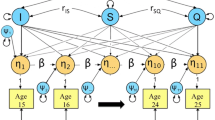Abstract
The present study evaluated gene by development interaction in cigarettes smoked per day (CPD) in a longitudinal community-representative sample (N = 3,231) of Caucasian twins measured at ages 14, 17, 20, and 24. Biometric heritability analyses show strong heritabilities and shared environmental influences, as well as cross-age genetic and shared environmental correlations. Single nucleotide polymorphisms (SNPs) previously associated with CPD according to meta-analysis were summed to create a SNP score. At best, the SNP score accounted for 1 % of the variance in CPD. The results suggest developmental moderation with a larger significant SNP score effect on CPD at ages 20 and 24, and smaller non-significant effect at ages 14 and 17. These results are consistent with the notion that nicotine-specific genetic substance use risk is less important at younger ages, and becomes more important as individuals age into adulthood. In a complementary analysis, the same nicotine-relevant SNP score was unrelated to the frequency of alcohol use at ages 14, 17, 20, or 24. These results indicate that the SNP score is specific to nicotine in this small sample and that increased exposure to nicotine at ages 20 and 24 does not influence the extent of concurrent or later alcohol use. Increased sample sizes and replication or meta-analysis are necessary to confirm these results. The methods and results illustrate the importance and difficulty of considering developmental processes in understanding the interplay of genes and environment.


Similar content being viewed by others
Notes
Note that we also conducted all analyses with a subsample of individuals who, at any one assessment where either (1) a current smoker or (2) had been a smoker in the past. Current smoker was defined just as in the current smoking sample described in the text. To be a past smoker, we required that an individual report smoking on average one cigarette per day for 12 months. The results from this sample did not change in any significant way.
References
Allen HL, Estrada K, Lettre G, Berndt SI, Weedon MN, Rivadeneira F et al (2010) Hundreds of variants clustered in genomic loci and biological pathways affect human height. Nature 467(7317):832–838
Altshuler DL, Durbin RM, Abecasis GR, Bentley DR, Chakravarti A, Clark AG et al (2010) A map of human genome variation from population-scale sequencing. Nature 467(7319):1061–1073
Boker S, Neale M, Maes H, Wilde M, Spiegel M, Brick T et al (2011) OpenMx: an open source extended structural equation modeling framework. Psychometrika 76(2):306–317
Burton PR, Hansell AL, Fortier I, Manolio TA, Khoury MJ, Little J et al (2009) Size matters: just how big is BIG? Quantifying realistic sample size requirements for human genome epidemiology. Int J Epidemiol 38(1):263–273
Caspi A, Hariri AR, Holmes A, Uher R, Moffitt TE (2010) Genetic sensitivity to the environment: the case of the serotonin transporter gene and its implications for studying complex diseases and traits. Am J Psychiatry 167(5):509–527
Center for Disease Control and Prevention (2005) Annual smoking-attributable mortality, years of potential life lost, and productivity losses. Morb Mortal Wkly Rep 54(25):3
Cummings KM, Fong GT, Borland R (2009) Environmental influences on tobacco use: evidence from societal and community influences on tobacco use and dependence. Ann Rev Clin Psychol 5:433–458
Curran PJ, Bauer DJ (2011) The disaggregation of within-person and between-person effects in longitudinal models of change. Annu Rev Psychol 62(62):583–619
Curry SJ, Mermelstein RJ, Sporer AK (2009) Therapy for specific problems: youth tobacco cessation. Annu Rev Psychol 60:229–255
Ebrahim S, Smith GD (2008) Mendelian randomization: can genetic epidemiology help redress the failures of observational epidemiology? Hum Genet 123(1):15–33
Elashoff JD, Cantor RM, Shain S (1991) Power and validity of methods to identify variability genes. Genet Epidemiol 8(6):381–388
Fong GT, Hammond D, Laux FL, Zanna MP, Cummings KM, Borland R et al (2004) The near-universal experience of regret among smokers in four countries: findings from the International Tobacco Control Policy Evaluation Survey. Nicotine Tob Res 6:341–351
Furberg H, Kim Y, Dackor J, Boerwinkle E, Franceschini N, Ardissino D et al (2010) Genome-wide meta-analyses identify multiple loci associated with smoking behavior. Nat Genet 42(5):441–447
Gibbons RD, Hedeker D, DuToit S (2010) Advances in analysis of longitudinal data. Annu Rev Clin Psychol 6(6):79–107
Iacono WG, McGue M (2002) Minnesota twin family study. Twin Res 5(6):482–487
Iacono WG, Malone SM, McGue M (2008) Behavioral disinhibition and the development of early-onset addiction: common and specific influences. Annu Rev Clin Psychol 4:325–348
Irons DE, McGue M, Iacono WG, Oetting WS (2007) Mendelian randomization: a novel test of the gateway hypothesis and models of gene-environment interplay. Dev Psychopathol 19(4):1181–1195
Irons DE, Iacono WG, Oetting WS, McGue M (2012) Developmental trajectory and environmental moderation of the effect of ALDH2 polymporphism on alcohol use. Alcohol: Clin Exp Res
Jaffee SR, Price TS (2007) Gene-environment correlations: a review of the evidence and implications for prevention of mental illness. Mol Psychiatry 1(1):1–11
Kandel DB, Jessor R (2002) The gateway hypothesis revisited. In: Kandel DB (ed) Stages and pathways of drug involvement. Cambridge University Press, New York
Kendler KS, Jacobson KC, Prescott CA, Neale MC (2003a) Specificity of genetic and environmental risk factors for use and abuse/dependence of cannabis, cocaine, hallucinogens, sedatives, stimulants, and opiates in male twins. Am J Psychiatry 160(4):687–695
Kendler KS, Prescott CA, Myers J, Neale MC (2003b) The structure of genetic and environmental risk factors for common psychiatric and substance use disorders in men and women. Arch Gen Psychiatry 60(9):929–937
Li Y, Willer C, Sanna S, Abecasis G (2009) Genotype Imputation. Annu Rev Genomics Hum Genet 10:387–406
Li Y, Willer CJ, Ding J, Scheet P, Abecasis GR (2010) MaCH: using sequence and genotype data to estimate haplotypes and unobserved genotypes. Genet Epidemiol 34(8):816–834
Maes HH, Sullivan PF, Bulik CM, Neale MC, Prescott CA, Eaves LJ et al (2004) A twin study of genetic and environmental influences on tobacco initiation, regular tobacco use and nicotine dependence. Psychol Med 34(7):1251–1261
Magnus P, Berg K, Borresen AL, Nance WE (1981) Apparent influence of marker genotypes on variation in serum-cholesterol in monozygotic twins. Clin Genet 19(1):67–70
Manolio TA, Bailey-Wilson JE, Collins FS (2006) Opinion—genes, environment and the value of prospective cohort studies. Nat Rev Genet 7(10):812–820
Manolio TA, Collins FS, Cox NJ, Goldstein DB, Hindorff LA, Hunter DJ et al (2009) Finding the missing heritability of complex diseases. Nature 461(7265):747–753
Miller MB, Neale MC (1995) Using nonlinear constraints in Mx to automate estimation of confidence-intervals for parameters in genetic models. Behav Genet 25(3):279–280
Montgomery SB, Lappalainen T, Gutierrez-Arcelus M, Dermitzakis ET (2011) Rare and common regulatory variation in population-scale sequenced human genomes. PLoS Genet 7(7):e1002144
Neale MC, Cardon LR (1992) Methodology for genetic studies of twins and families. Kluwer Academic, Dortrecht
Neale MC, Miller MB (1997) The use of likelihood-based confidence intervals in genetic models. Behav Genet 27:113–120
Nelson DE, Giovino GA, Shopland DR, Mowery PD, Mills SL, Eriksen MP (1995) Trends in cigarette-smoking among US adolescents, 1974 through 1991. Am J Public Health 85(1):34–40
Pare G, Cook NR, Ridker PM, Chasman DI (2010) On the use of variance per genotype as a tool to identify quantitative trait interaction effects: a report from the Women’s Genome Health Study. PLoS Genet 6(6):1–12
Pinheiro JC, Bates DM (2000) Mixed-effects models in S and S-PLUS. Springer, New York
Price AL, Patterson NJ, Plenge RM, Weinblatt ME, Shadick NA, Reich D (2006) Principal components analysis corrects for stratification in genome-wide association studies. Nat Genet 38(8):904–909
R Development Core Team (2011) R: a language and environment for statistical computing. R Foundation for Statistical Computing, Vienna. ISBN 3-900051-07-0, http://www.R-project.org
Ray R, Lerman C, Tyndale RF (2009) Nicotine dependence pharmacogenetics: role of genetic variation in nicotine-metabolizing enzymes. J Neurogenet 23(3):252–261
Robins LN, Babor TF, Cottler LB (1987) Composite International Diagnostic Interview: expanded substance abuse module. St. Louis, Washington
Sareen J, Bolton J, Cox B, Clara I (2006) Use of alcohol and drugs to self-medicate anxiety disorders in a nationally representative sample. J Nerv Mental Dis 194(11):818–825
Schatzkin A, Abnet CC, Cross AJ, Gunter M, Pfeiffer R, Gail M et al (2009) Mendelian randomization: How it can-and cannot-help confirm causal relations between nutrition and cancer. Cancer Prev Res 2(2):104–113
Smith GD (2011) Mendelian randomization for strengthening causal inference in observational studies: application to gene × environment interactions (vol 5, pg 527, 2010). Perspectives Psychol Sci 6(3), 314–314
Smith GD, Ebrahim S (2003) Mendelian randomization: can genetic epidemiology contribute to understanding environmental determinants of disease? Int J Epidemiol 32(1):1–22
Smith GD, Ebrahim S (2005) What can mendelian randomisation tell us about modifiable behavioural and environmental exposures? Br Med J 330:1076–1079
Speliotes EK, Willer CJ, Berndt SI, Monda KL, Thorleifsson G, Jackson AU et al (2010) Association analyses of 249,796 individuals reveal 18 new loci associated with body mass index. Nat Genet 42(11):937-U953
Sullivan PF, Cichon S, Craddock N, Daly M, Faraone SV, Gejman PV et al (2009) A framework for interpreting genome-wide association studies of psychiatric disorders The Psychiatric GWAS Consortium Steering Committee. Mol Psychiatry 14(1):10–17
Thomas DC (2010a) Gene-environment-wide association studies: emerging approaches. Nat Rev Genet 11(4):259–272
Thomas DC (2010b) Methods for investigating gene-environment interactions in candidate pathway and genome-wide association studies. Annu Rev Public Health 31(31):21–36
Thorgeirsson TE, Gudbjartsson DF, Surakka I, Vink JM, Amin N, Geller F et al (2010) Sequence variants at CHRNB3-CHRNA6 and CYP2A6 affect smoking behavior. Nat Genet 42(5):448-U135
Timpson NJ, Lawlor DA, Harbord RM, Gaunt TR, Day INM, Palmer LJ et al (2005) C-reactive protein and its role in metabolic syndrome: Mendelian randomisation study. Lancet 366(9501):1954–1959
University of Michigan (2007) Monitoring the Future. Trends in cigarette smoking and smokeless tobacco
Vink JM, Smit AB, de Geus EJC, Sullivan P, Willemsen G, Hottenga JJ et al (2009) Genome-wide association study of smoking initiation and current smoking. Am J Hum Genet 84(3):367–379
Visscher PM, Yang JA, Goddard ME (2010) A Commentary on ‘Common SNPs Explain a Large Proportion of the Heritability for Human Height’ by Yang et al. (2010). Twin Res Hum Genet 13(6):517–524
Vrieze SI, McGue M, Miller MB, Legrand LN, Schork NJ, Iacono WG (2011) An assessment of the individual and collective effects of variants on height using twins and a developmentally informative study design. PLoS Genet 7(12):e1002413
Willer CJ, Sanna S, Jackson AU, Scuteri A, Bonnycastle LL, Clarke R et al (2008) Newly identified loci that influence lipid concentrations and risk of coronary artery disease. Nat Genet 40(2):161–169
Miller MB, Basu S, Cunningham J, Oetting W, Schork NJ, Iacono WG et al (2012). The Minnesota Center for Twin and Family Research Genome-Wide Association Study
Yang JA, Benyamin B, McEvoy BP, Gordon S, Henders AK, Nyholt DR et al (2010) Common SNPs explain a large proportion of the heritability for human height. Nat Genet 42(7):565-U131
Acknowledgments
This work was supported by grants R37 DA 05147, R01 DA 13240, and U01 DA 024417 of the National Institute on Drug Abuse; R01 AA 09367 of the National Institute on Alcohol Abuse and Alcoholism; and 5T32 MH 017069 (Vrieze) of the National Institute of Mental Health.
Author information
Authors and Affiliations
Corresponding author
Electronic supplementary material
Below is the link to the electronic supplementary material.
Rights and permissions
About this article
Cite this article
Vrieze, S.I., McGue, M. & Iacono, W.G. The interplay of genes and adolescent development in substance use disorders: leveraging findings from GWAS meta-analyses to test developmental hypotheses about nicotine consumption. Hum Genet 131, 791–801 (2012). https://doi.org/10.1007/s00439-012-1167-1
Received:
Accepted:
Published:
Issue Date:
DOI: https://doi.org/10.1007/s00439-012-1167-1




